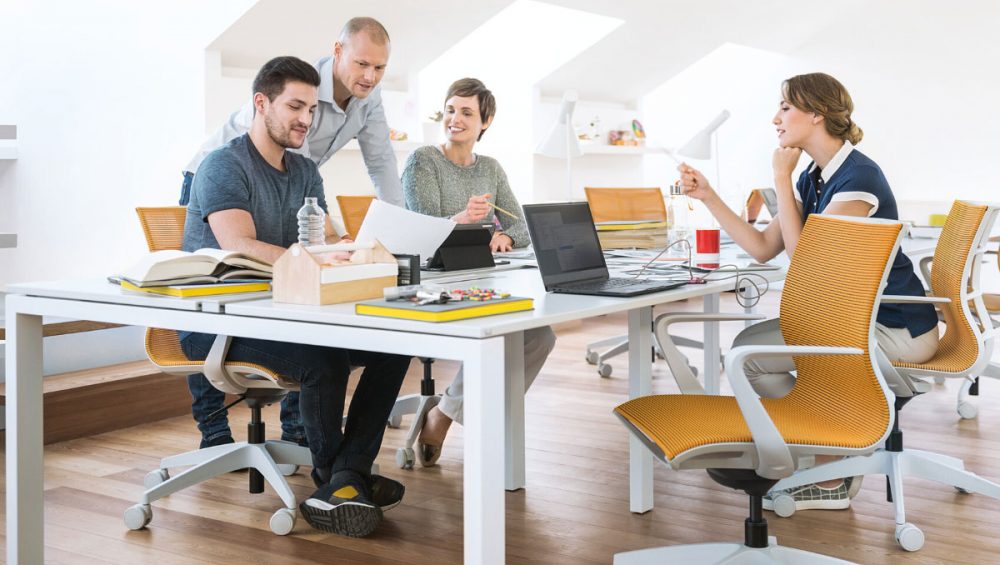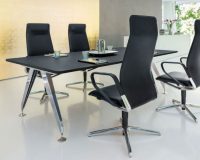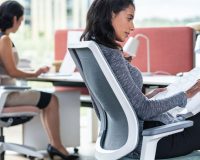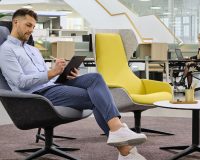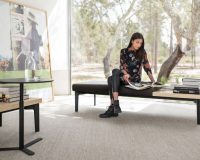Productivity for knowledge workers is not just measured in the amount of work they do, but their results. This can be frustrating when it comes to assessing outputs, especially in a macroeconomic sense for modern service based economies, but it needs to be assessed and we need to establish the factors that help knowledge workers be more innovative, collaborative and productive. In other words, productivity goes hand in hand with creativity.
Fortunately, we have a great deal of research on the sort of working culture and environment helps them to innovate.
To start with, a culture of innovation is likely to be reflected in an innovative approach to workplace design. This is why so many of the world’s great innovators, especially in the tech and creative sectors, inhabit offices that do away with sterile, traditional office design characteristics and incorporate more characterful elements and features that are obviously focused on creativity such as writable walls and plenty of informal meeting space. However, such characteristics cannot be simply imposed on a company that does not have an innovative culture. That must always come first.
We also know from both anecdotal and research evidence that our best ideas often come when our mind is wandering because we are focused on something else. Brainstorming may throw up ideas, and there should always be space for intense ideas generation, but the eureka moments often come when we are staring out of the window or going for a walk. So, any design should also allow for this.
The chance to think
Quiet work is not just about silence, but also a chance to think, muse and let the mind do its work. Daydreaming may be frowned upon in a traditional working culture, but it actually has a number of benefits for individuals and hence the firms that employ them. People enter a meditative state which allows for the processing of information from short term to long term memory. This process is often disrupted by technology and disruptions and we should rediscover the lost art of doing nothing if we are to benefit from the brain’s ability to process our thoughts and information into something productive.
It should almost go without saying that different types of meeting space produce different outcomes. In this regard, there is much the office can learn from the new forms of learning now commonplace in the higher education sector. The shift away from didactic forms of learning in which knowledge is transmitted from a lecturer or tutor to a room of largely silent student should be reflected in a similar shift in office design.
However, choice of settings is not just about the type of work carried out in the office but the different personality types that inhabit it. While creative workers may not work as well in a formal meeting space, there is always room to offer people choice.
Fostering creativity
There are other functional aspects of creativity that the workplace should foster. According to a study from Dr Nigel Oseland and Alexi Marmot Associates, innovation is about implementing an idea, not just coming up with an idea. It requires people to come together to share and test ideas along with bouts of solo activity when the idea is developed alone. This is something that can be done at home or in the office in specifically designed spaces.
Indeed, proximity to other people plays an important role in innovation. In their book The Organization and Architecture of Innovation, the academics Gunter Henn and Tom Allen present research demonstrating how organisational structure and physical space affect communication between people working in technical and knowledge based fields and they demonstrate how organisations can ‘transform both to increase the transfer of technical knowledge and maximize the communication for inspiration that is central to the innovation process’.
One other factor that seems to be important is the ability to experience new things. This has always been a challenge in an office setting which by its nature is fixed, but a workplace design that focuses on experiences and not just space can go a long way towards this within a culture that encourages people to work in different ways and different places. A perfect example of this can be found at the Sedus Smart Office.
A study carried out at Radboud University in the Netherlands found not only that the best ideas came from a pool of ideas but also that environments and cultures that disrupt routines actually create new synaptic pathways in the brain and hence new ideas. A workplace based on unallocated spaces and a choice of settings is cited in the research as a way of getting people away from their routines.
Another underappreciated workplace design element is nature. A 2015 report led by organisational psychologist Cary Cooper called The Global Impact of Biophilic Design in the Workplace found that employees who work in environments with natural elements report a 15 percent higher level of wellbeing, are 6 percent more productive and 15 percent more creative overall.
We may not always find it easy to measure productivity and creativity, but we know more and more about how to achieve them.

